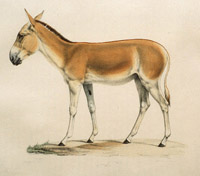
Erforschung biologischer Ressourcen der Mongolei / Exploration into the Biological Resources of Mongolia, ISSN 0440-1298
Date of this Version
2007
Document Type
Article
Citation
Erforschung biologischer Ressourcen der Mongolei (2007) band 10: 227-230.
Abstract
The species-rank of Equus kiang was recently supported by molecular and genetic studies (RYDER & CHEMNICK 1990). Three subspecies are currently recognized in this species: eastern - E. k. holdereri, southern - E. k. polyodon and western - E. k. kiang, differing in some cranial and external features (GROVES & MAZAK 1967). Kiang populations are scarce and widely separated at present; which was a reason for a reassessment of the taxonomic status and distribution of at least one or two of these three races.
An interesting skull of kiang was recovered by N. Paklina and C. van Orden from Ladakh (India) in 2001. It is the only kiang skull from the most western population in Russian zoological collections. Museum materials can be divided into two groups. One (wild) group of specimens originated from North and North-East Tibet, including skulls and skins collected by Russian scientists and travellers: N.M. Przewalskji (in 1886), G.E. and M.E. Grum-Grzhimailo (in 1890), P.K. Kozlov (in 1900). These animals putatively belong to E. k. holdereri. The second group (captive) consists of animals from zoos, belonging to E. k. holdereri, too. The association of the Ladakh skull is questionable. Both groups (wild and captive) differ well in terms of skull proportions (38 % measurements and 19 % indexes, p < 0.05), but there is some overlap in their cranial variability. The mentioned skull from Ladakh is also intermediate with respect to cranial features. Discriminant function analysis (Statistica for Windows 6.0) based on a set of cranial measurements distinguishes these two groups well (Wilks lambda = 0.0006), and ascribes the skull from Ladakh to the captive group (by Squared Mahalanobis distance and Posterior probabilities).
This result supports the view that the kiang populations from East Ladakh, North and North-East Tibet belong to the same subspecies - E. k. kiang. Results also demonstrate trends of cranial variability in animals bred in captivity.
Included in
Asian Studies Commons, Biodiversity Commons, Environmental Sciences Commons, Nature and Society Relations Commons, Other Animal Sciences Commons, Terrestrial and Aquatic Ecology Commons, Zoology Commons


Comments
Copyright 2007, Martin-Luther-Universität Halle Wittenberg, Halle (Saale). Used by permission.